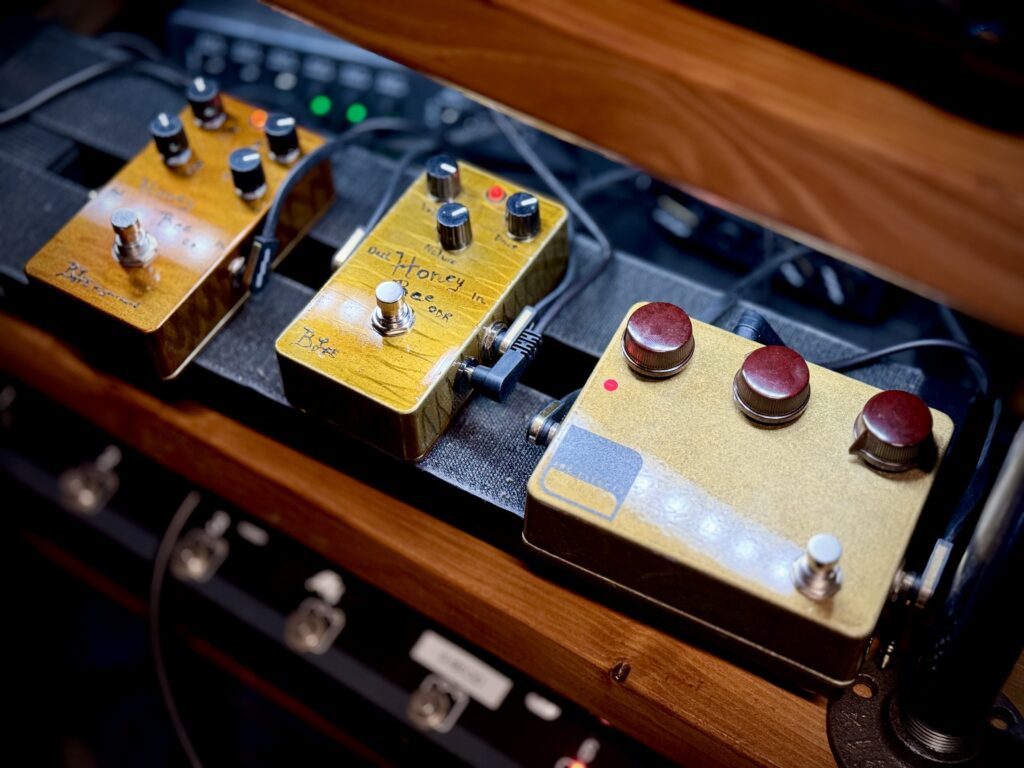I recently bought a Blackstar Debut 100RH amp head.
This is going to be an additional pedal platform amp. Read on for my first impressions.
Continue reading “First Impressions: Blackstar Debut 100RH Amp Head”
Tone. At Home.
I recently bought a Blackstar Debut 100RH amp head.
This is going to be an additional pedal platform amp. Read on for my first impressions.
Continue reading “First Impressions: Blackstar Debut 100RH Amp Head”Earlier this month, I picked up one of my holy grail pedals: a Honey Bee OD made by BJFe.

What do I think of it? Read on for my First Impressions.
Continue reading “First Impressions: BJFe Honey Bee OD Retro”‘Studio Diary’ is an occasional series where I talk about building a home recording setup for hobbyists and enthusiasts like us. I share my personal experiences, and the thinking behind some of the decisions that I’ve made along the way.
Fractal Audio have recently overhauled their amp modelling in the Axe-FX 3 / FM-9 / FM-3. And my recent dive into the Orange Getaway Driver has shown me that I need to revoice my signal chain. I’m taking this as an opportunity to re-evaluate everything about the pedal preset I’ve built for the Axe-FX 3.
I spent most of Spring dividing my playing time between the pedal platform patches that are based on the DRRI and using my real Tweed Deluxe amp. When I came back to my original 57 Vintage and 65 Modern presets, I could hear a stark difference – and not in a good way.
So, before I finally wrap up this series on the pedal platform patches, I want to go back and re-master those two original pedal platform presets. There’s been some recent Axe-FX 3 firmware updates that make this easier to do and sound better than ever.
Continue reading “Studio Diary #61: Remastering My Original Pedal Platform Presets For Axe-FX 3 Firmware 28.05”Quick Listen is where I capture and share guitar tones that I’ve dialled in. No exploration; little discussion – just a quick audio demo or two along with a documented signal chain.

Today, I’ve grabbed my Ritual Devices Grey Overdrive, to find out how well it can rock out when I’m playing single-coil bridge pickups.
Continue reading “Quick Listen: Ritual Devices Grey Overdrive With Strat And Tele Bridge Pickups”New year, new (and hopefully improved!) reference tone from my Fender 57 Custom Deluxe amp.
All made possible thanks to a late 2024 freebie from Origin Effects … and me figuring out how I’d been using my Fryette Power Station PS-100 wrong …
Continue reading “#TweedTone: Dialling In A 5e3 Tweed Deluxe Reference Tone For 2025”Quick Listen is where I capture and share guitar tones that I’ve dialled in. No exploration; little discussion – just a quick audio demo or two along with a documented signal chain.
Today, I’ve dusted off the plexi-style amp that I bought back in 2019, and paired it with a Gibson Les Paul and Celestion Creamback impulse responses. Have a listen.
Continue reading “Quick Listen: Plexi-Style Amp with a Les Paul”‘Studio Diary’ is an occasional series where I talk about building a home recording setup for hobbyists and enthusiasts like us. I share my personal experiences, and the thinking behind some of the decisions that I’ve made along the way.
Fractal Audio have recently overhauled their amp modelling in the Axe-FX 3 / FM-9 / FM-3. And my recent dive into the Orange Getaway Driver has shown me that I need to revoice my signal chain. I’m taking this as an opportunity to re-evaluate everything about the pedal preset I’ve built for the Axe-FX 3.
Last time, I covered how I’ve split my old ’65 Clean’ pedal platform preset into two, by adding a new ’65 Vintage’ preset based on the two Deluxe Reverb amp models. Yeah, turns out there’s a bit more mileage to be had out of those amp models …
Continue reading “Studio Diary #58: Introducing The 65 Nashville Pedal Platform Preset”‘Studio Diary’ is an occasional series where I talk about building a home recording setup for hobbyists and enthusiasts like us. I share my personal experiences, and the thinking behind some of the decisions that I’ve made along the way.
Fractal Audio have recently overhauled their amp modelling in the Axe-FX 3 / FM-9 / FM-3. And my recent dive into the Orange Getaway Driver has shown me that I need to revoice my signal chain. I’m taking this as an opportunity to re-evaluate everything about the pedal preset I’ve built for the Axe-FX 3.
I recently took a look at Umbrella Company’s Hitchhike Drive tweed-in-a-box overdrive pedal. The whole blog post ended up being rescued by the Axe-FX 3’s Deluxe Reverb amp model. Since then, I’ve tried it with a couple of other pedals and had a similar experience.
A single ’65 Clean’ pedal platform patch clearly isn’t enough. I need to split it up into two separate flavours.
Continue reading “Studio Diary #57: Splitting My 65 Clean Pedal Platform Patch In Two”Rather than do a ‘best of’ style post, every year I’m going to do a rundown of what amps I’m using for pedal platforms, and why.
Previous years: [2019] [2020] [2021]
Continue reading “2022 Review: Pedal Platform Amps”